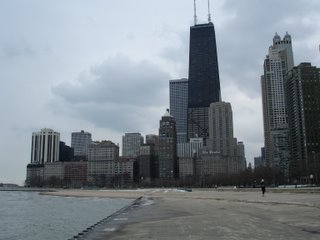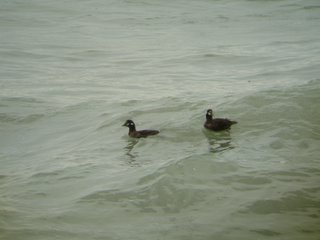***
Not too many months ago, news of the Ivory-billed Woodpecker's re-discovery absolutely rocked America's bird world. The phantom of the southern swamps was still beating its head against the hardwood wall, eking out a perilous survival. It was the find of the ages, and gave hope that this magnificent creature might live to fill our darkest waterways with its haunting magic. It also gave hope and possibility here in Galveston that another species missing for a half-century could re-appear and once again turn ornithology upside down.
We are speaking of the diminutive Eskimo Curlew. This slight species joined a number of other shorebirds in a fascinating migration which, in fall, took them east across Canada to the Atlantic Ocean, days of non-stop migration south, with an eventual destination of southern South America. In spring, though, these shorebirds return to America using trade winds across the Caribbean and Gulf of Mexico, with their sights set on the Texas Coast. Some of our most extravagant shorebirds are thus absent in the Galveston area in fall, but appear in splendor following winter, just after the vernal equinox. American Golden-Plovers, Hudsonian Godwits and Whimbrels make spring exciting to birders on their way up the Great Plains, but for five decades, they have not been accompanied by their tiny curlew-cousin.
The last Eskimo Curlew was seen and photographed on three consecutive springs from 1959-1962, by Victor Emanuel and others. It had not been seen for 17 years prior, and, of course, has not positively been seen since. Most birders would admit skepticism as to their continued existence, but healthy scientific skepticism should never be replaced by dogmatic close-mindedness. Therefore, buoyed by the recent discovery of Ivory-billed Woodpeckers in Arkansas, Galveston's favorite birding son, Ted Eubanks, Jr., has announced a "call to arms" to Texas birders.
This March, keep your eyes pealed as you drive near fields and pastures for a midget curlew waiting to explode onto the front pages of every newspaper in America. Eskimo Curlews are not terribly hard to separate from America's other shorebirds, and experts would recognize one at a glance (if they remained conscious). They are a medium-sized, brownish sandpiper (about the size of a bantam hen), and being a curlew they have a decurved (down-turned) bill. The Long-billed Curlew, frequently seen in our grassland habitats, is enormous, and the slightly smaller and grayer Whimbrel (still considerably larger than an Eskimo Curlew) has bold, dark stripes over the crown. The bill of the Eskimo Curlew is very thin and shorter than it two larger cousins, and there is no eye stripe, unlike other curlews.
There really exist relatively few records of this rarest-of-all birds even last century. But in the 1800s they blackened the skies of the Great Plains every spring, and were slaughtered mercilessly. Many draw parallels to the extinct Passenger Pigeon, undoubtedly the most abundant bird in our nation's history. It seems human nature abhors a food vacuum, and our history is to hunt species to extinction. Is the phantom curlew gone forever? Or, like the Lord God Woodpecker, will Mother Nature give us a second chance?
These are questions not even the best American ornithologists can answer. Perhaps the larger question is, "Will we ever learn?"
The Galveston Ornithological Society is offering a $1000 reward to anyone finding an Eskimo Curlew, where is becomes documented through photography. Observers may call anytime, (409) 737-4081, or (409) 370-1515. Ted Eubanks may be reached at (409) 770-9668.




